HLTH 1037 Case Study: Mental Health Treatment and Nursing Approach
VerifiedAdded on 2022/10/01
|16
|3005
|8
Case Study
AI Summary
This case study examines Ms. Amanda, a 28-year-old woman with a 15-year history of bipolar disorder, who recently attempted suicide due to a relapse. The case details her history of medication (Lithium carbonate and Quetiapine), side effects, and multiple psychiatric admissions, highlighting the need for improved post-discharge support. It explores critical questions regarding psychological strategies, medication side-effect management, environmental triggers, and early intervention measures. The investigation delves into the chronic nature of bipolar disorder, its impact on the patient's mental and physical health, and the effectiveness of pharmacotherapy and psychotherapy. The case also analyzes the nursing approach, including the need for a patient-centered care plan, safety precautions, and professional conduct. The study emphasizes the importance of empathy, effective communication, and therapeutic relationships in providing holistic care for patients with bipolar disorder, reflecting on the nurse's conduct and the significance of patient-centered care.
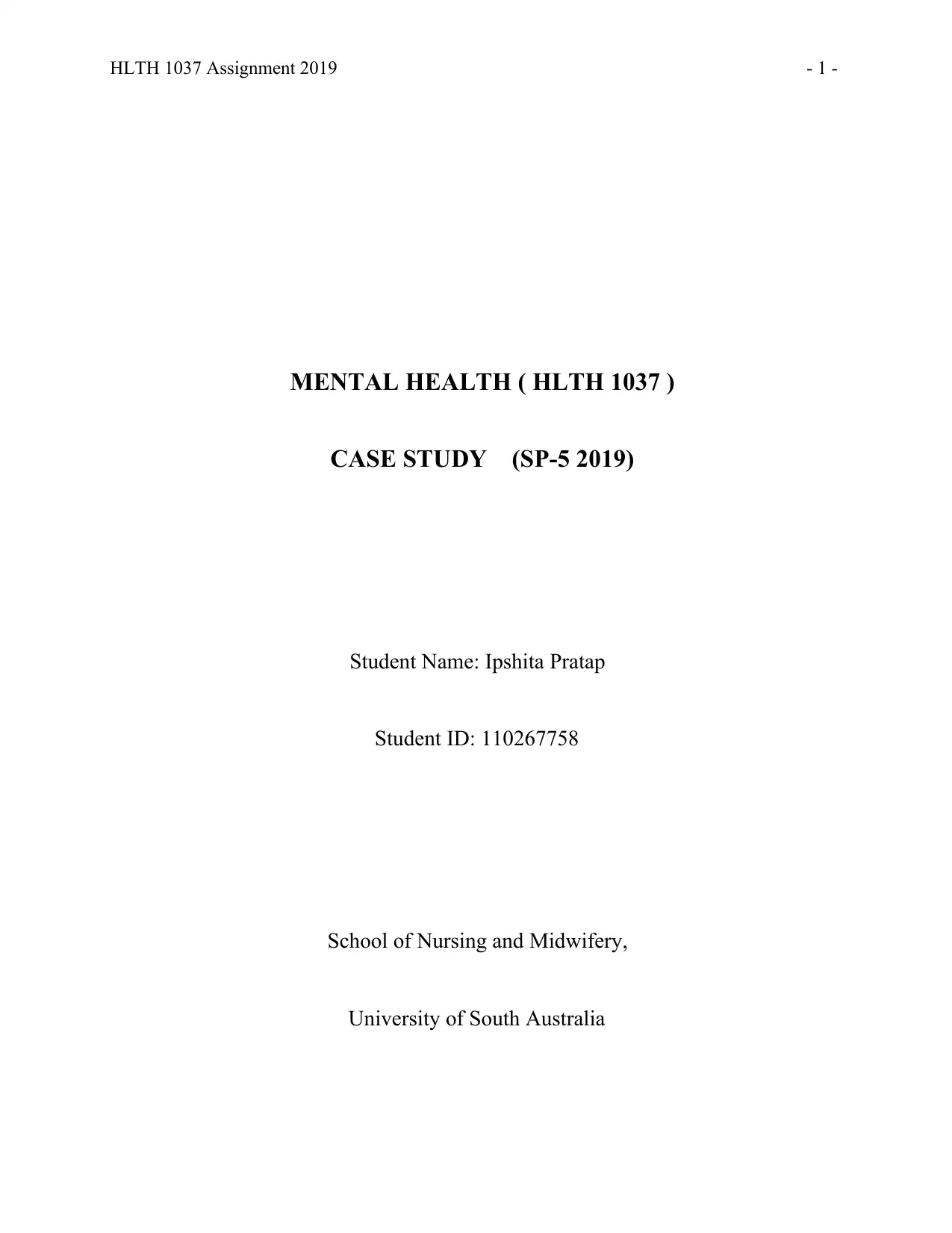
HLTH 1037 Assignment 2019 - 1 -
MENTAL HEALTH ( HLTH 1037 )
CASE STUDY (SP-5 2019)
Student Name: Ipshita Pratap
Student ID: 110267758
School of Nursing and Midwifery,
University of South Australia
MENTAL HEALTH ( HLTH 1037 )
CASE STUDY (SP-5 2019)
Student Name: Ipshita Pratap
Student ID: 110267758
School of Nursing and Midwifery,
University of South Australia
Paraphrase This Document
Need a fresh take? Get an instant paraphrase of this document with our AI Paraphraser
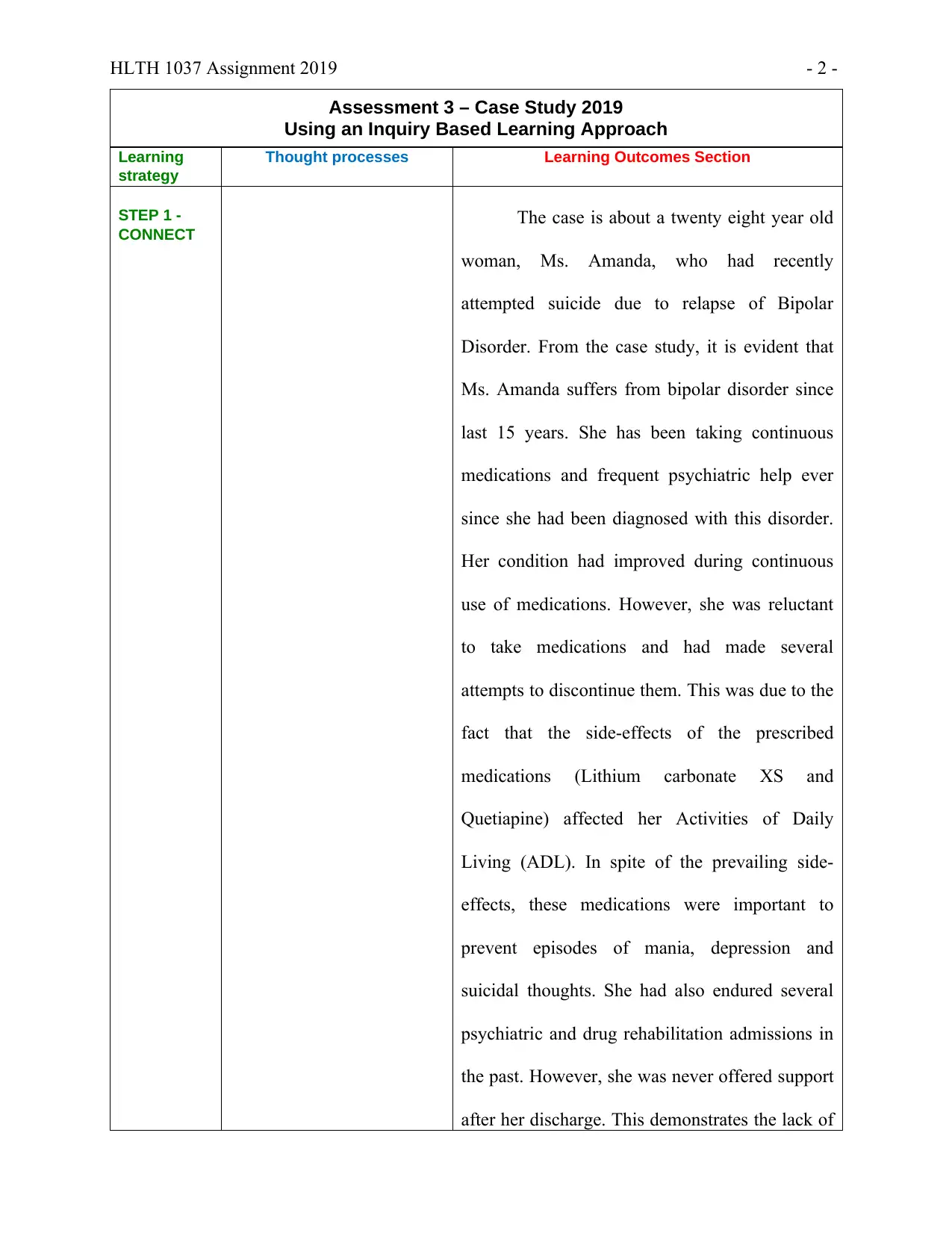
HLTH 1037 Assignment 2019 - 2 -
Assessment 3 – Case Study 2019
Using an Inquiry Based Learning Approach
Learning
strategy
Thought processes Learning Outcomes Section
STEP 1 -
CONNECT
The case is about a twenty eight year old
woman, Ms. Amanda, who had recently
attempted suicide due to relapse of Bipolar
Disorder. From the case study, it is evident that
Ms. Amanda suffers from bipolar disorder since
last 15 years. She has been taking continuous
medications and frequent psychiatric help ever
since she had been diagnosed with this disorder.
Her condition had improved during continuous
use of medications. However, she was reluctant
to take medications and had made several
attempts to discontinue them. This was due to the
fact that the side-effects of the prescribed
medications (Lithium carbonate XS and
Quetiapine) affected her Activities of Daily
Living (ADL). In spite of the prevailing side-
effects, these medications were important to
prevent episodes of mania, depression and
suicidal thoughts. She had also endured several
psychiatric and drug rehabilitation admissions in
the past. However, she was never offered support
after her discharge. This demonstrates the lack of
Assessment 3 – Case Study 2019
Using an Inquiry Based Learning Approach
Learning
strategy
Thought processes Learning Outcomes Section
STEP 1 -
CONNECT
The case is about a twenty eight year old
woman, Ms. Amanda, who had recently
attempted suicide due to relapse of Bipolar
Disorder. From the case study, it is evident that
Ms. Amanda suffers from bipolar disorder since
last 15 years. She has been taking continuous
medications and frequent psychiatric help ever
since she had been diagnosed with this disorder.
Her condition had improved during continuous
use of medications. However, she was reluctant
to take medications and had made several
attempts to discontinue them. This was due to the
fact that the side-effects of the prescribed
medications (Lithium carbonate XS and
Quetiapine) affected her Activities of Daily
Living (ADL). In spite of the prevailing side-
effects, these medications were important to
prevent episodes of mania, depression and
suicidal thoughts. She had also endured several
psychiatric and drug rehabilitation admissions in
the past. However, she was never offered support
after her discharge. This demonstrates the lack of
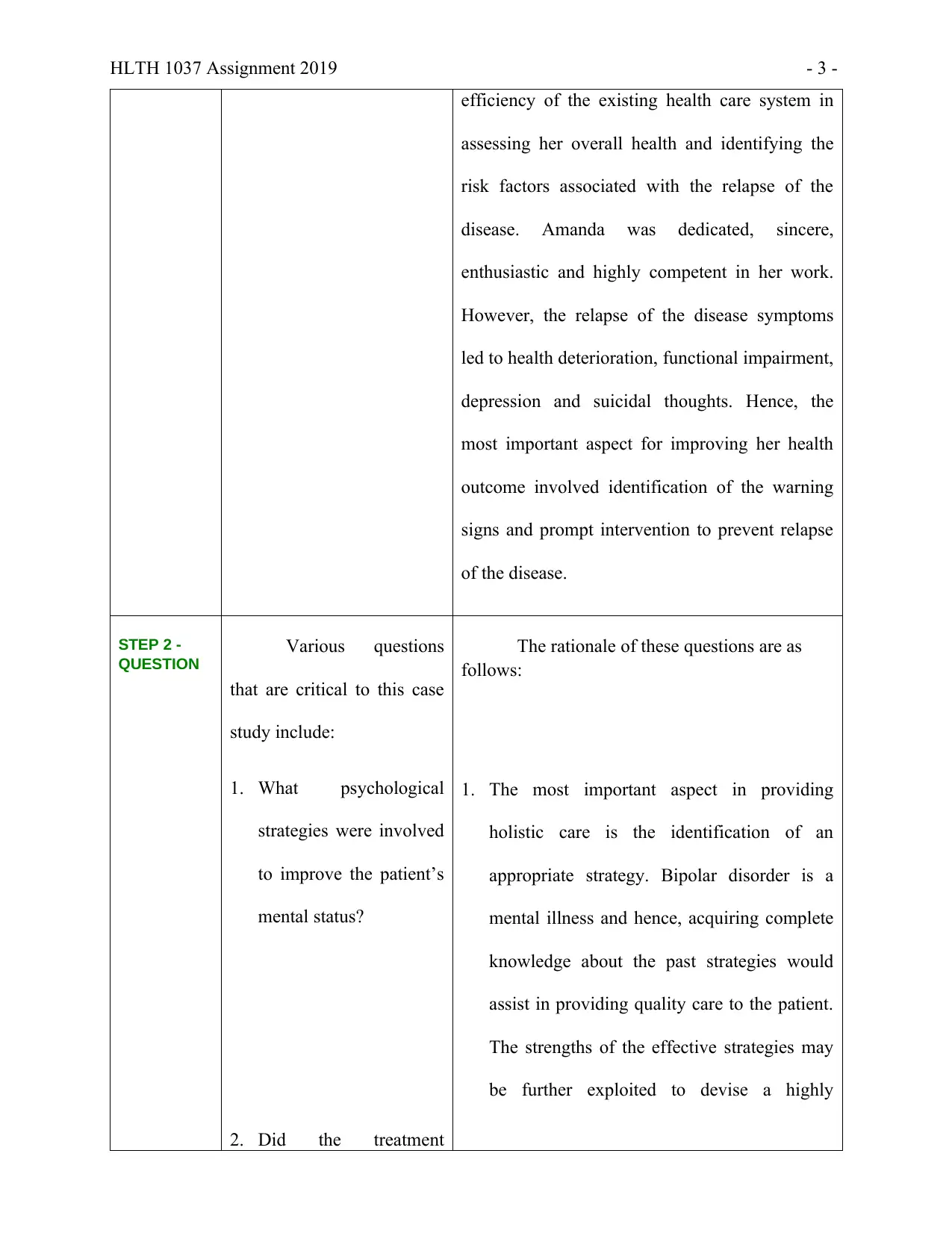
HLTH 1037 Assignment 2019 - 3 -
efficiency of the existing health care system in
assessing her overall health and identifying the
risk factors associated with the relapse of the
disease. Amanda was dedicated, sincere,
enthusiastic and highly competent in her work.
However, the relapse of the disease symptoms
led to health deterioration, functional impairment,
depression and suicidal thoughts. Hence, the
most important aspect for improving her health
outcome involved identification of the warning
signs and prompt intervention to prevent relapse
of the disease.
STEP 2 -
QUESTION
Various questions
that are critical to this case
study include:
1. What psychological
strategies were involved
to improve the patient’s
mental status?
2. Did the treatment
The rationale of these questions are as
follows:
1. The most important aspect in providing
holistic care is the identification of an
appropriate strategy. Bipolar disorder is a
mental illness and hence, acquiring complete
knowledge about the past strategies would
assist in providing quality care to the patient.
The strengths of the effective strategies may
be further exploited to devise a highly
efficiency of the existing health care system in
assessing her overall health and identifying the
risk factors associated with the relapse of the
disease. Amanda was dedicated, sincere,
enthusiastic and highly competent in her work.
However, the relapse of the disease symptoms
led to health deterioration, functional impairment,
depression and suicidal thoughts. Hence, the
most important aspect for improving her health
outcome involved identification of the warning
signs and prompt intervention to prevent relapse
of the disease.
STEP 2 -
QUESTION
Various questions
that are critical to this case
study include:
1. What psychological
strategies were involved
to improve the patient’s
mental status?
2. Did the treatment
The rationale of these questions are as
follows:
1. The most important aspect in providing
holistic care is the identification of an
appropriate strategy. Bipolar disorder is a
mental illness and hence, acquiring complete
knowledge about the past strategies would
assist in providing quality care to the patient.
The strengths of the effective strategies may
be further exploited to devise a highly
⊘ This is a preview!⊘
Do you want full access?
Subscribe today to unlock all pages.

Trusted by 1+ million students worldwide
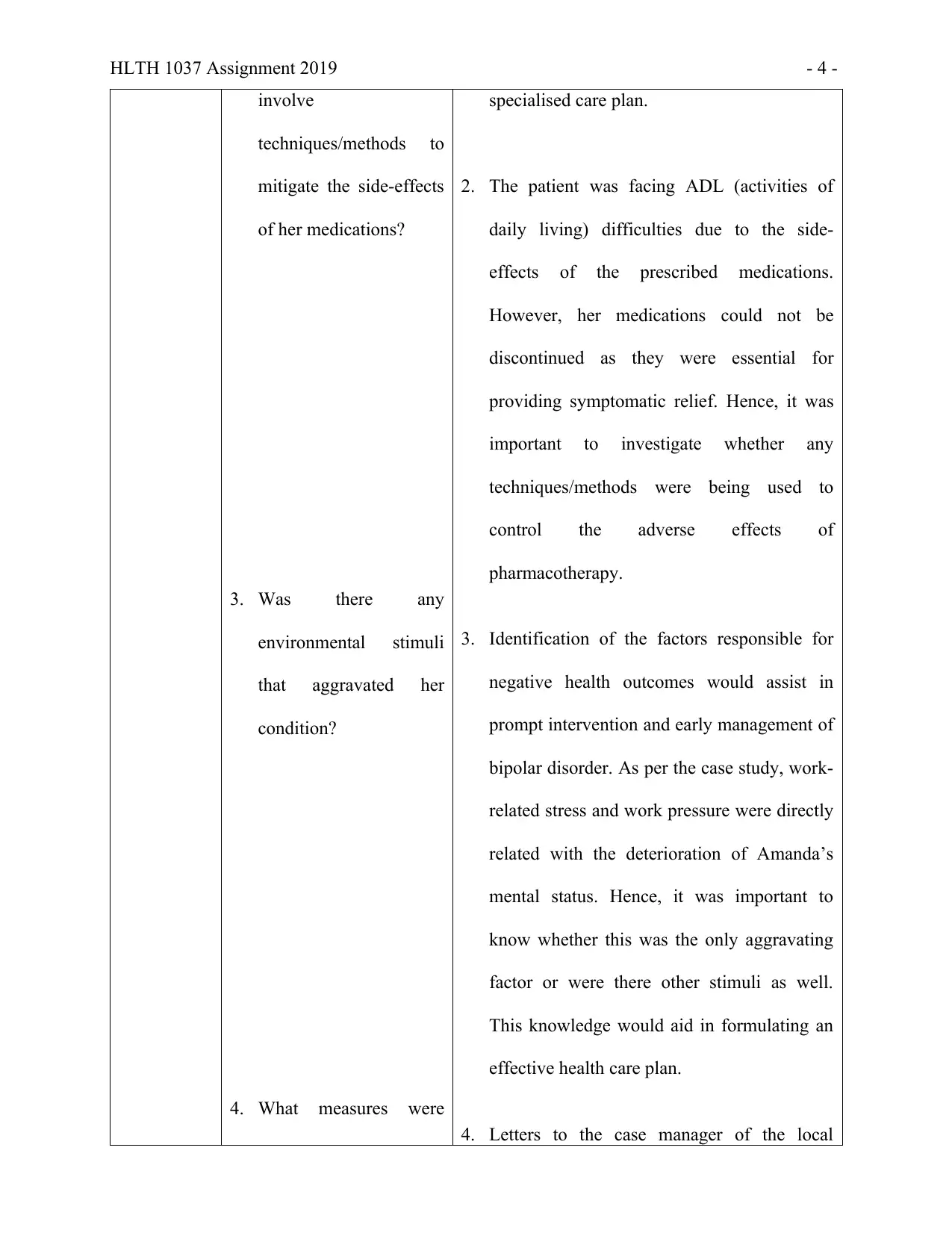
HLTH 1037 Assignment 2019 - 4 -
involve
techniques/methods to
mitigate the side-effects
of her medications?
3. Was there any
environmental stimuli
that aggravated her
condition?
4. What measures were
specialised care plan.
2. The patient was facing ADL (activities of
daily living) difficulties due to the side-
effects of the prescribed medications.
However, her medications could not be
discontinued as they were essential for
providing symptomatic relief. Hence, it was
important to investigate whether any
techniques/methods were being used to
control the adverse effects of
pharmacotherapy.
3. Identification of the factors responsible for
negative health outcomes would assist in
prompt intervention and early management of
bipolar disorder. As per the case study, work-
related stress and work pressure were directly
related with the deterioration of Amanda’s
mental status. Hence, it was important to
know whether this was the only aggravating
factor or were there other stimuli as well.
This knowledge would aid in formulating an
effective health care plan.
4. Letters to the case manager of the local
involve
techniques/methods to
mitigate the side-effects
of her medications?
3. Was there any
environmental stimuli
that aggravated her
condition?
4. What measures were
specialised care plan.
2. The patient was facing ADL (activities of
daily living) difficulties due to the side-
effects of the prescribed medications.
However, her medications could not be
discontinued as they were essential for
providing symptomatic relief. Hence, it was
important to investigate whether any
techniques/methods were being used to
control the adverse effects of
pharmacotherapy.
3. Identification of the factors responsible for
negative health outcomes would assist in
prompt intervention and early management of
bipolar disorder. As per the case study, work-
related stress and work pressure were directly
related with the deterioration of Amanda’s
mental status. Hence, it was important to
know whether this was the only aggravating
factor or were there other stimuli as well.
This knowledge would aid in formulating an
effective health care plan.
4. Letters to the case manager of the local
Paraphrase This Document
Need a fresh take? Get an instant paraphrase of this document with our AI Paraphraser
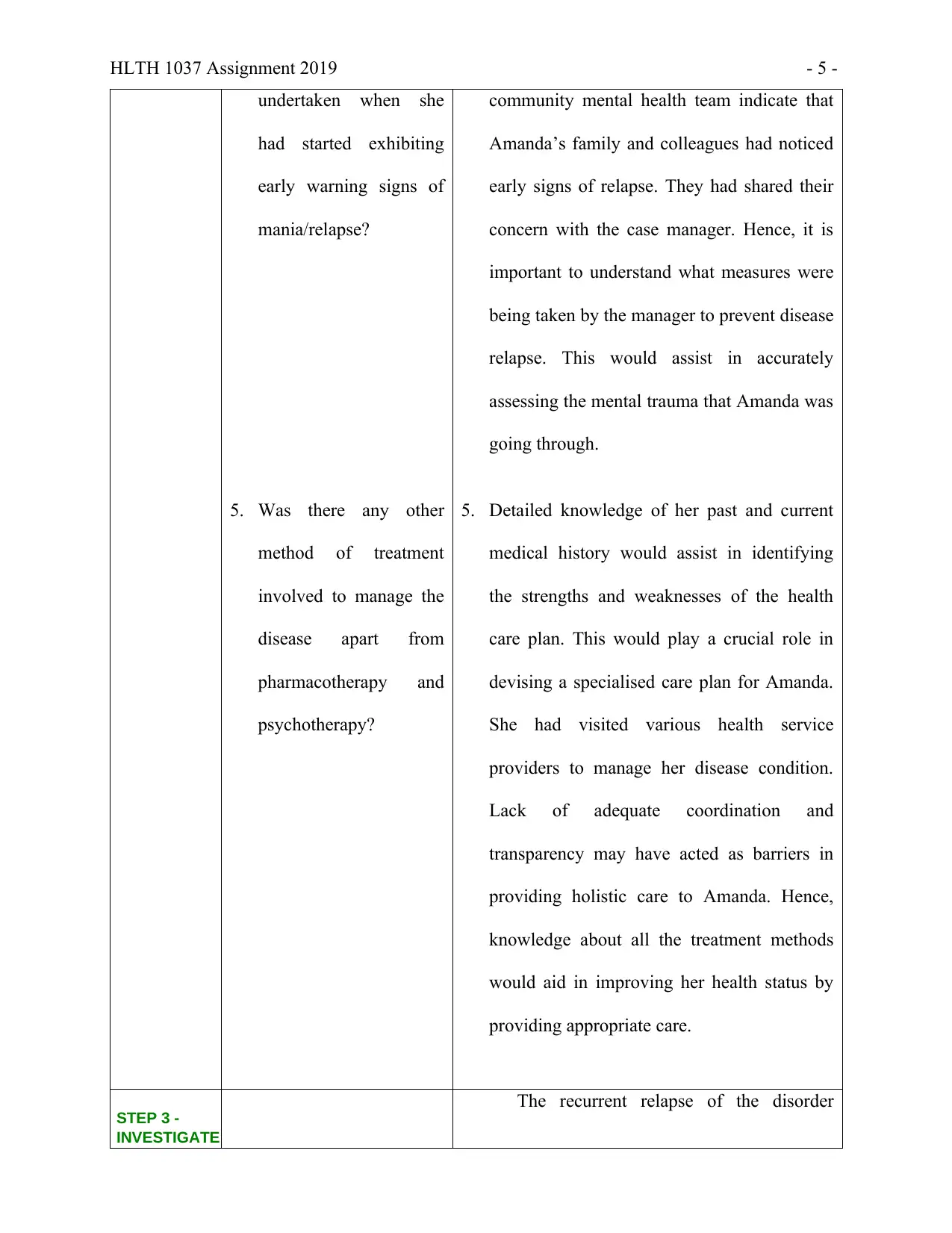
HLTH 1037 Assignment 2019 - 5 -
undertaken when she
had started exhibiting
early warning signs of
mania/relapse?
5. Was there any other
method of treatment
involved to manage the
disease apart from
pharmacotherapy and
psychotherapy?
community mental health team indicate that
Amanda’s family and colleagues had noticed
early signs of relapse. They had shared their
concern with the case manager. Hence, it is
important to understand what measures were
being taken by the manager to prevent disease
relapse. This would assist in accurately
assessing the mental trauma that Amanda was
going through.
5. Detailed knowledge of her past and current
medical history would assist in identifying
the strengths and weaknesses of the health
care plan. This would play a crucial role in
devising a specialised care plan for Amanda.
She had visited various health service
providers to manage her disease condition.
Lack of adequate coordination and
transparency may have acted as barriers in
providing holistic care to Amanda. Hence,
knowledge about all the treatment methods
would aid in improving her health status by
providing appropriate care.
STEP 3 -
INVESTIGATE
The recurrent relapse of the disorder
undertaken when she
had started exhibiting
early warning signs of
mania/relapse?
5. Was there any other
method of treatment
involved to manage the
disease apart from
pharmacotherapy and
psychotherapy?
community mental health team indicate that
Amanda’s family and colleagues had noticed
early signs of relapse. They had shared their
concern with the case manager. Hence, it is
important to understand what measures were
being taken by the manager to prevent disease
relapse. This would assist in accurately
assessing the mental trauma that Amanda was
going through.
5. Detailed knowledge of her past and current
medical history would assist in identifying
the strengths and weaknesses of the health
care plan. This would play a crucial role in
devising a specialised care plan for Amanda.
She had visited various health service
providers to manage her disease condition.
Lack of adequate coordination and
transparency may have acted as barriers in
providing holistic care to Amanda. Hence,
knowledge about all the treatment methods
would aid in improving her health status by
providing appropriate care.
STEP 3 -
INVESTIGATE
The recurrent relapse of the disorder
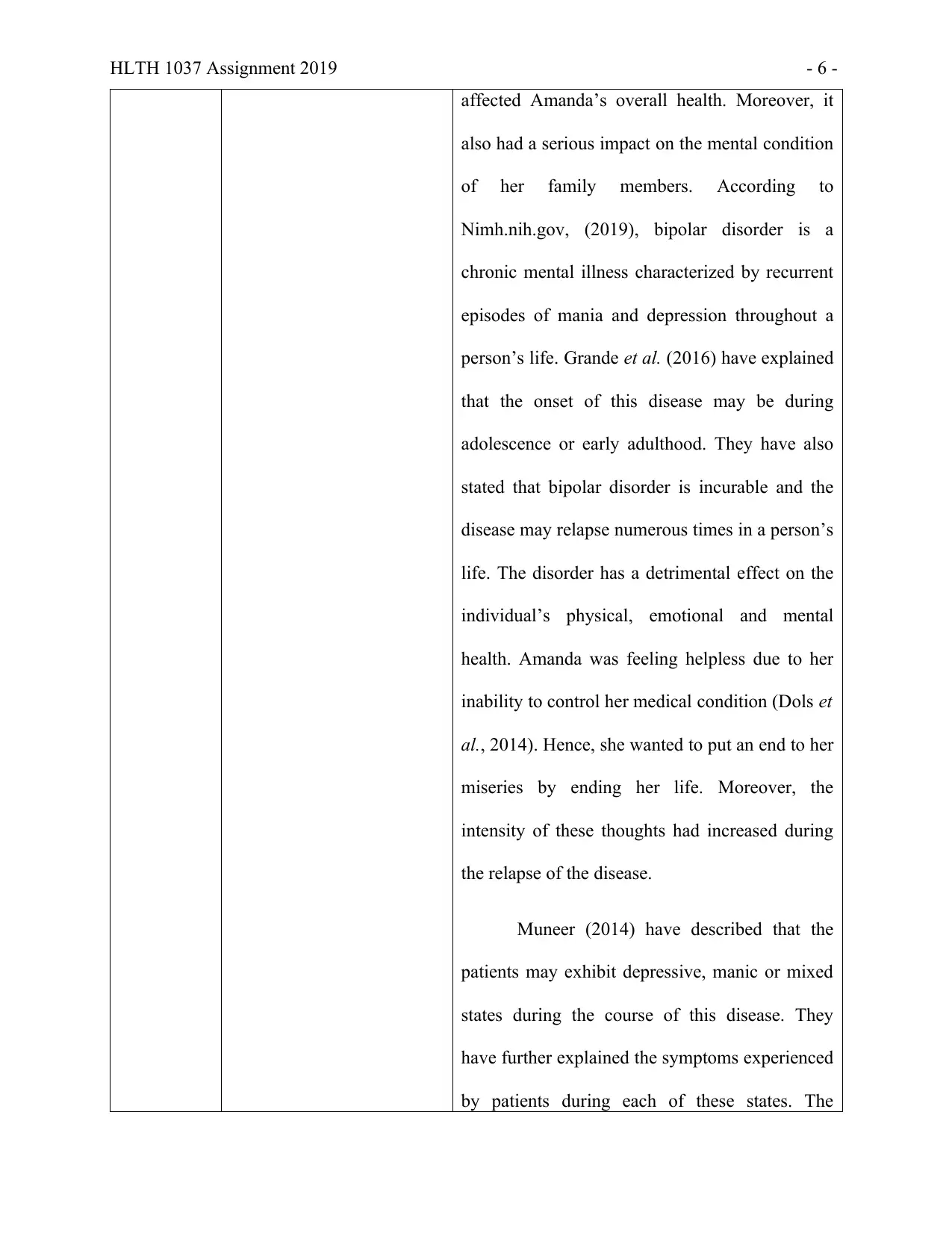
HLTH 1037 Assignment 2019 - 6 -
affected Amanda’s overall health. Moreover, it
also had a serious impact on the mental condition
of her family members. According to
Nimh.nih.gov, (2019), bipolar disorder is a
chronic mental illness characterized by recurrent
episodes of mania and depression throughout a
person’s life. Grande et al. (2016) have explained
that the onset of this disease may be during
adolescence or early adulthood. They have also
stated that bipolar disorder is incurable and the
disease may relapse numerous times in a person’s
life. The disorder has a detrimental effect on the
individual’s physical, emotional and mental
health. Amanda was feeling helpless due to her
inability to control her medical condition (Dols et
al., 2014). Hence, she wanted to put an end to her
miseries by ending her life. Moreover, the
intensity of these thoughts had increased during
the relapse of the disease.
Muneer (2014) have described that the
patients may exhibit depressive, manic or mixed
states during the course of this disease. They
have further explained the symptoms experienced
by patients during each of these states. The
affected Amanda’s overall health. Moreover, it
also had a serious impact on the mental condition
of her family members. According to
Nimh.nih.gov, (2019), bipolar disorder is a
chronic mental illness characterized by recurrent
episodes of mania and depression throughout a
person’s life. Grande et al. (2016) have explained
that the onset of this disease may be during
adolescence or early adulthood. They have also
stated that bipolar disorder is incurable and the
disease may relapse numerous times in a person’s
life. The disorder has a detrimental effect on the
individual’s physical, emotional and mental
health. Amanda was feeling helpless due to her
inability to control her medical condition (Dols et
al., 2014). Hence, she wanted to put an end to her
miseries by ending her life. Moreover, the
intensity of these thoughts had increased during
the relapse of the disease.
Muneer (2014) have described that the
patients may exhibit depressive, manic or mixed
states during the course of this disease. They
have further explained the symptoms experienced
by patients during each of these states. The
⊘ This is a preview!⊘
Do you want full access?
Subscribe today to unlock all pages.

Trusted by 1+ million students worldwide
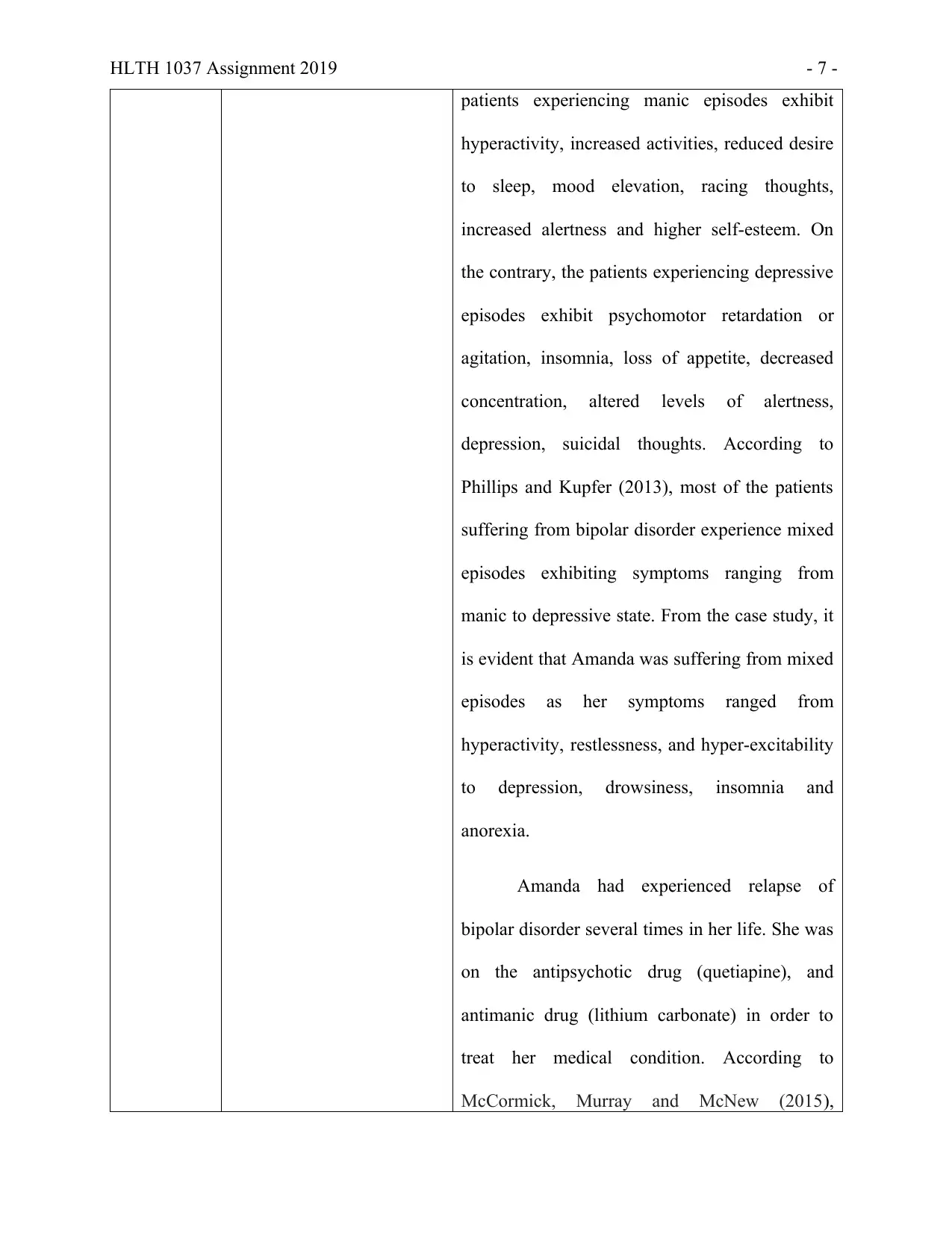
HLTH 1037 Assignment 2019 - 7 -
patients experiencing manic episodes exhibit
hyperactivity, increased activities, reduced desire
to sleep, mood elevation, racing thoughts,
increased alertness and higher self-esteem. On
the contrary, the patients experiencing depressive
episodes exhibit psychomotor retardation or
agitation, insomnia, loss of appetite, decreased
concentration, altered levels of alertness,
depression, suicidal thoughts. According to
Phillips and Kupfer (2013), most of the patients
suffering from bipolar disorder experience mixed
episodes exhibiting symptoms ranging from
manic to depressive state. From the case study, it
is evident that Amanda was suffering from mixed
episodes as her symptoms ranged from
hyperactivity, restlessness, and hyper-excitability
to depression, drowsiness, insomnia and
anorexia.
Amanda had experienced relapse of
bipolar disorder several times in her life. She was
on the antipsychotic drug (quetiapine), and
antimanic drug (lithium carbonate) in order to
treat her medical condition. According to
McCormick, Murray and McNew (2015),
patients experiencing manic episodes exhibit
hyperactivity, increased activities, reduced desire
to sleep, mood elevation, racing thoughts,
increased alertness and higher self-esteem. On
the contrary, the patients experiencing depressive
episodes exhibit psychomotor retardation or
agitation, insomnia, loss of appetite, decreased
concentration, altered levels of alertness,
depression, suicidal thoughts. According to
Phillips and Kupfer (2013), most of the patients
suffering from bipolar disorder experience mixed
episodes exhibiting symptoms ranging from
manic to depressive state. From the case study, it
is evident that Amanda was suffering from mixed
episodes as her symptoms ranged from
hyperactivity, restlessness, and hyper-excitability
to depression, drowsiness, insomnia and
anorexia.
Amanda had experienced relapse of
bipolar disorder several times in her life. She was
on the antipsychotic drug (quetiapine), and
antimanic drug (lithium carbonate) in order to
treat her medical condition. According to
McCormick, Murray and McNew (2015),
Paraphrase This Document
Need a fresh take? Get an instant paraphrase of this document with our AI Paraphraser
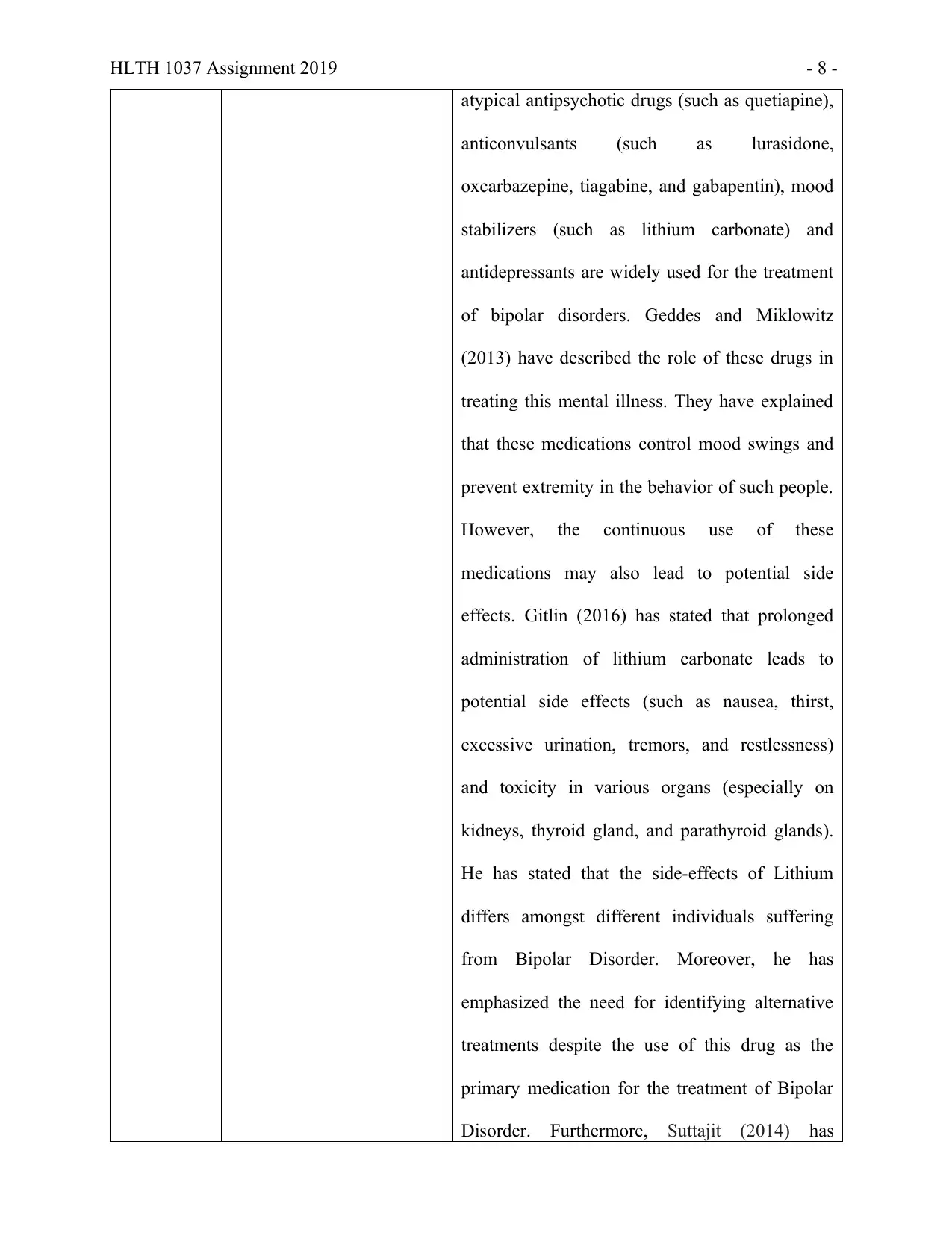
HLTH 1037 Assignment 2019 - 8 -
atypical antipsychotic drugs (such as quetiapine),
anticonvulsants (such as lurasidone,
oxcarbazepine, tiagabine, and gabapentin), mood
stabilizers (such as lithium carbonate) and
antidepressants are widely used for the treatment
of bipolar disorders. Geddes and Miklowitz
(2013) have described the role of these drugs in
treating this mental illness. They have explained
that these medications control mood swings and
prevent extremity in the behavior of such people.
However, the continuous use of these
medications may also lead to potential side
effects. Gitlin (2016) has stated that prolonged
administration of lithium carbonate leads to
potential side effects (such as nausea, thirst,
excessive urination, tremors, and restlessness)
and toxicity in various organs (especially on
kidneys, thyroid gland, and parathyroid glands).
He has stated that the side-effects of Lithium
differs amongst different individuals suffering
from Bipolar Disorder. Moreover, he has
emphasized the need for identifying alternative
treatments despite the use of this drug as the
primary medication for the treatment of Bipolar
Disorder. Furthermore, Suttajit (2014) has
atypical antipsychotic drugs (such as quetiapine),
anticonvulsants (such as lurasidone,
oxcarbazepine, tiagabine, and gabapentin), mood
stabilizers (such as lithium carbonate) and
antidepressants are widely used for the treatment
of bipolar disorders. Geddes and Miklowitz
(2013) have described the role of these drugs in
treating this mental illness. They have explained
that these medications control mood swings and
prevent extremity in the behavior of such people.
However, the continuous use of these
medications may also lead to potential side
effects. Gitlin (2016) has stated that prolonged
administration of lithium carbonate leads to
potential side effects (such as nausea, thirst,
excessive urination, tremors, and restlessness)
and toxicity in various organs (especially on
kidneys, thyroid gland, and parathyroid glands).
He has stated that the side-effects of Lithium
differs amongst different individuals suffering
from Bipolar Disorder. Moreover, he has
emphasized the need for identifying alternative
treatments despite the use of this drug as the
primary medication for the treatment of Bipolar
Disorder. Furthermore, Suttajit (2014) has
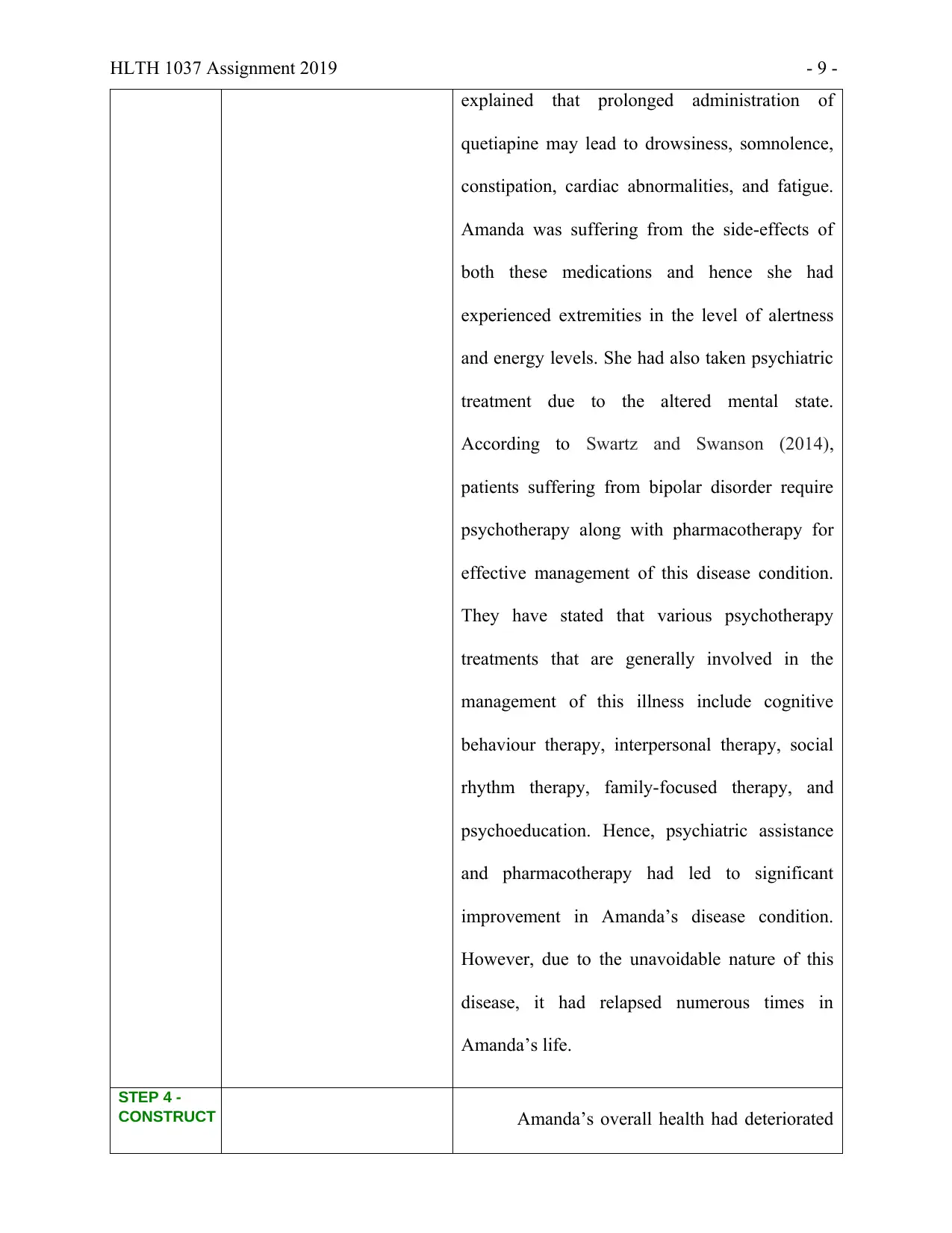
HLTH 1037 Assignment 2019 - 9 -
explained that prolonged administration of
quetiapine may lead to drowsiness, somnolence,
constipation, cardiac abnormalities, and fatigue.
Amanda was suffering from the side-effects of
both these medications and hence she had
experienced extremities in the level of alertness
and energy levels. She had also taken psychiatric
treatment due to the altered mental state.
According to Swartz and Swanson (2014),
patients suffering from bipolar disorder require
psychotherapy along with pharmacotherapy for
effective management of this disease condition.
They have stated that various psychotherapy
treatments that are generally involved in the
management of this illness include cognitive
behaviour therapy, interpersonal therapy, social
rhythm therapy, family-focused therapy, and
psychoeducation. Hence, psychiatric assistance
and pharmacotherapy had led to significant
improvement in Amanda’s disease condition.
However, due to the unavoidable nature of this
disease, it had relapsed numerous times in
Amanda’s life.
STEP 4 -
CONSTRUCT Amanda’s overall health had deteriorated
explained that prolonged administration of
quetiapine may lead to drowsiness, somnolence,
constipation, cardiac abnormalities, and fatigue.
Amanda was suffering from the side-effects of
both these medications and hence she had
experienced extremities in the level of alertness
and energy levels. She had also taken psychiatric
treatment due to the altered mental state.
According to Swartz and Swanson (2014),
patients suffering from bipolar disorder require
psychotherapy along with pharmacotherapy for
effective management of this disease condition.
They have stated that various psychotherapy
treatments that are generally involved in the
management of this illness include cognitive
behaviour therapy, interpersonal therapy, social
rhythm therapy, family-focused therapy, and
psychoeducation. Hence, psychiatric assistance
and pharmacotherapy had led to significant
improvement in Amanda’s disease condition.
However, due to the unavoidable nature of this
disease, it had relapsed numerous times in
Amanda’s life.
STEP 4 -
CONSTRUCT Amanda’s overall health had deteriorated
⊘ This is a preview!⊘
Do you want full access?
Subscribe today to unlock all pages.

Trusted by 1+ million students worldwide
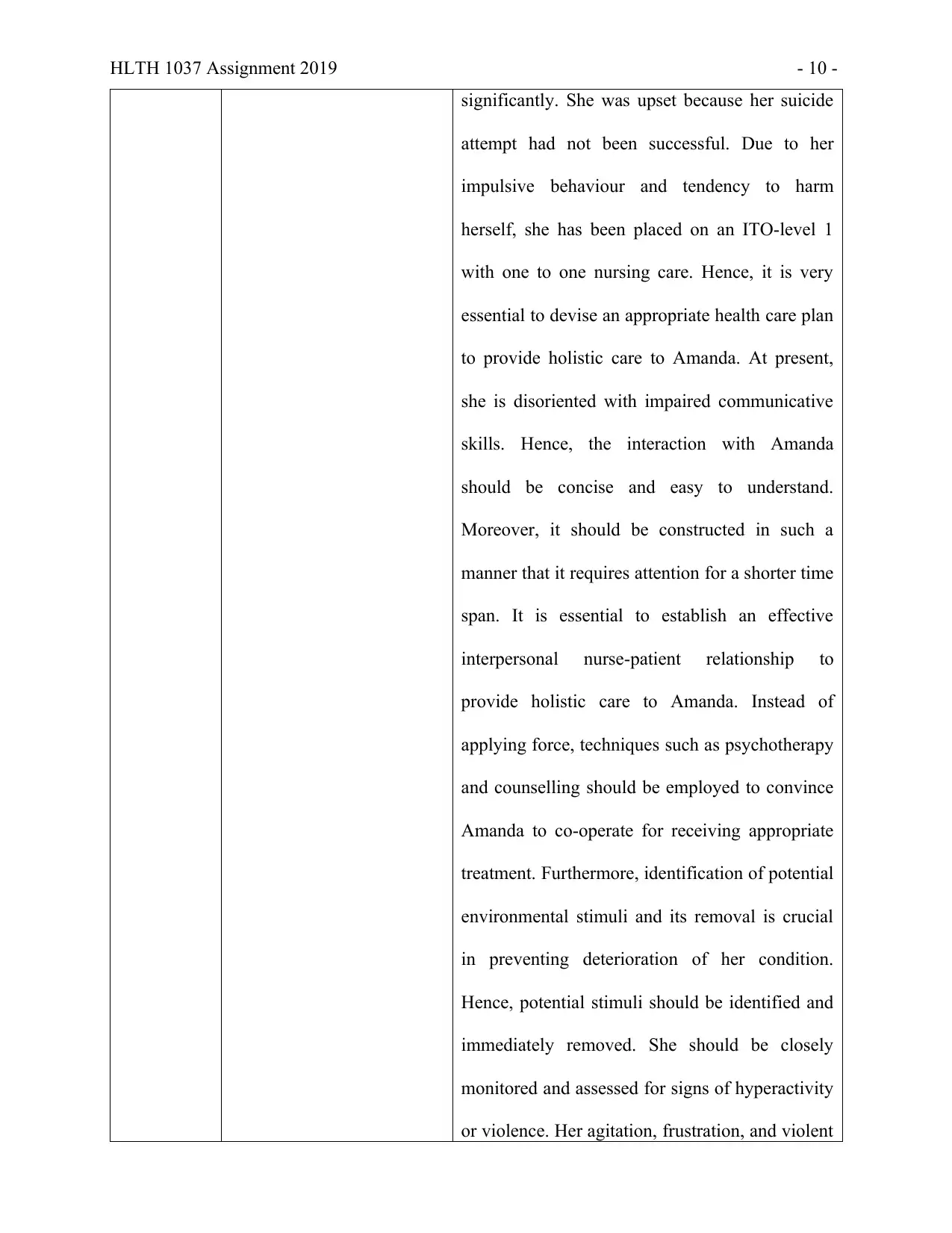
HLTH 1037 Assignment 2019 - 10 -
significantly. She was upset because her suicide
attempt had not been successful. Due to her
impulsive behaviour and tendency to harm
herself, she has been placed on an ITO-level 1
with one to one nursing care. Hence, it is very
essential to devise an appropriate health care plan
to provide holistic care to Amanda. At present,
she is disoriented with impaired communicative
skills. Hence, the interaction with Amanda
should be concise and easy to understand.
Moreover, it should be constructed in such a
manner that it requires attention for a shorter time
span. It is essential to establish an effective
interpersonal nurse-patient relationship to
provide holistic care to Amanda. Instead of
applying force, techniques such as psychotherapy
and counselling should be employed to convince
Amanda to co-operate for receiving appropriate
treatment. Furthermore, identification of potential
environmental stimuli and its removal is crucial
in preventing deterioration of her condition.
Hence, potential stimuli should be identified and
immediately removed. She should be closely
monitored and assessed for signs of hyperactivity
or violence. Her agitation, frustration, and violent
significantly. She was upset because her suicide
attempt had not been successful. Due to her
impulsive behaviour and tendency to harm
herself, she has been placed on an ITO-level 1
with one to one nursing care. Hence, it is very
essential to devise an appropriate health care plan
to provide holistic care to Amanda. At present,
she is disoriented with impaired communicative
skills. Hence, the interaction with Amanda
should be concise and easy to understand.
Moreover, it should be constructed in such a
manner that it requires attention for a shorter time
span. It is essential to establish an effective
interpersonal nurse-patient relationship to
provide holistic care to Amanda. Instead of
applying force, techniques such as psychotherapy
and counselling should be employed to convince
Amanda to co-operate for receiving appropriate
treatment. Furthermore, identification of potential
environmental stimuli and its removal is crucial
in preventing deterioration of her condition.
Hence, potential stimuli should be identified and
immediately removed. She should be closely
monitored and assessed for signs of hyperactivity
or violence. Her agitation, frustration, and violent
Paraphrase This Document
Need a fresh take? Get an instant paraphrase of this document with our AI Paraphraser
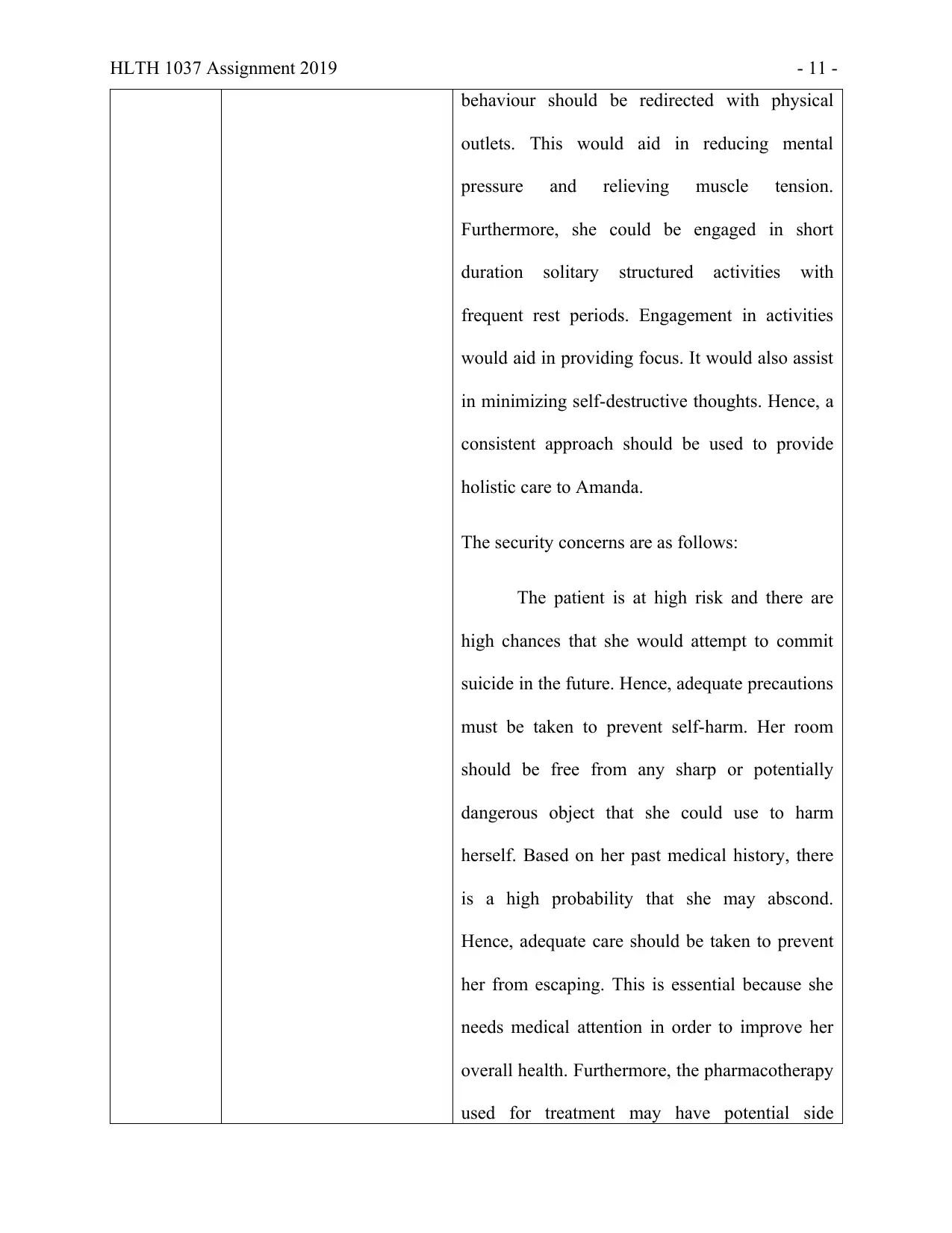
HLTH 1037 Assignment 2019 - 11 -
behaviour should be redirected with physical
outlets. This would aid in reducing mental
pressure and relieving muscle tension.
Furthermore, she could be engaged in short
duration solitary structured activities with
frequent rest periods. Engagement in activities
would aid in providing focus. It would also assist
in minimizing self-destructive thoughts. Hence, a
consistent approach should be used to provide
holistic care to Amanda.
The security concerns are as follows:
The patient is at high risk and there are
high chances that she would attempt to commit
suicide in the future. Hence, adequate precautions
must be taken to prevent self-harm. Her room
should be free from any sharp or potentially
dangerous object that she could use to harm
herself. Based on her past medical history, there
is a high probability that she may abscond.
Hence, adequate care should be taken to prevent
her from escaping. This is essential because she
needs medical attention in order to improve her
overall health. Furthermore, the pharmacotherapy
used for treatment may have potential side
behaviour should be redirected with physical
outlets. This would aid in reducing mental
pressure and relieving muscle tension.
Furthermore, she could be engaged in short
duration solitary structured activities with
frequent rest periods. Engagement in activities
would aid in providing focus. It would also assist
in minimizing self-destructive thoughts. Hence, a
consistent approach should be used to provide
holistic care to Amanda.
The security concerns are as follows:
The patient is at high risk and there are
high chances that she would attempt to commit
suicide in the future. Hence, adequate precautions
must be taken to prevent self-harm. Her room
should be free from any sharp or potentially
dangerous object that she could use to harm
herself. Based on her past medical history, there
is a high probability that she may abscond.
Hence, adequate care should be taken to prevent
her from escaping. This is essential because she
needs medical attention in order to improve her
overall health. Furthermore, the pharmacotherapy
used for treatment may have potential side
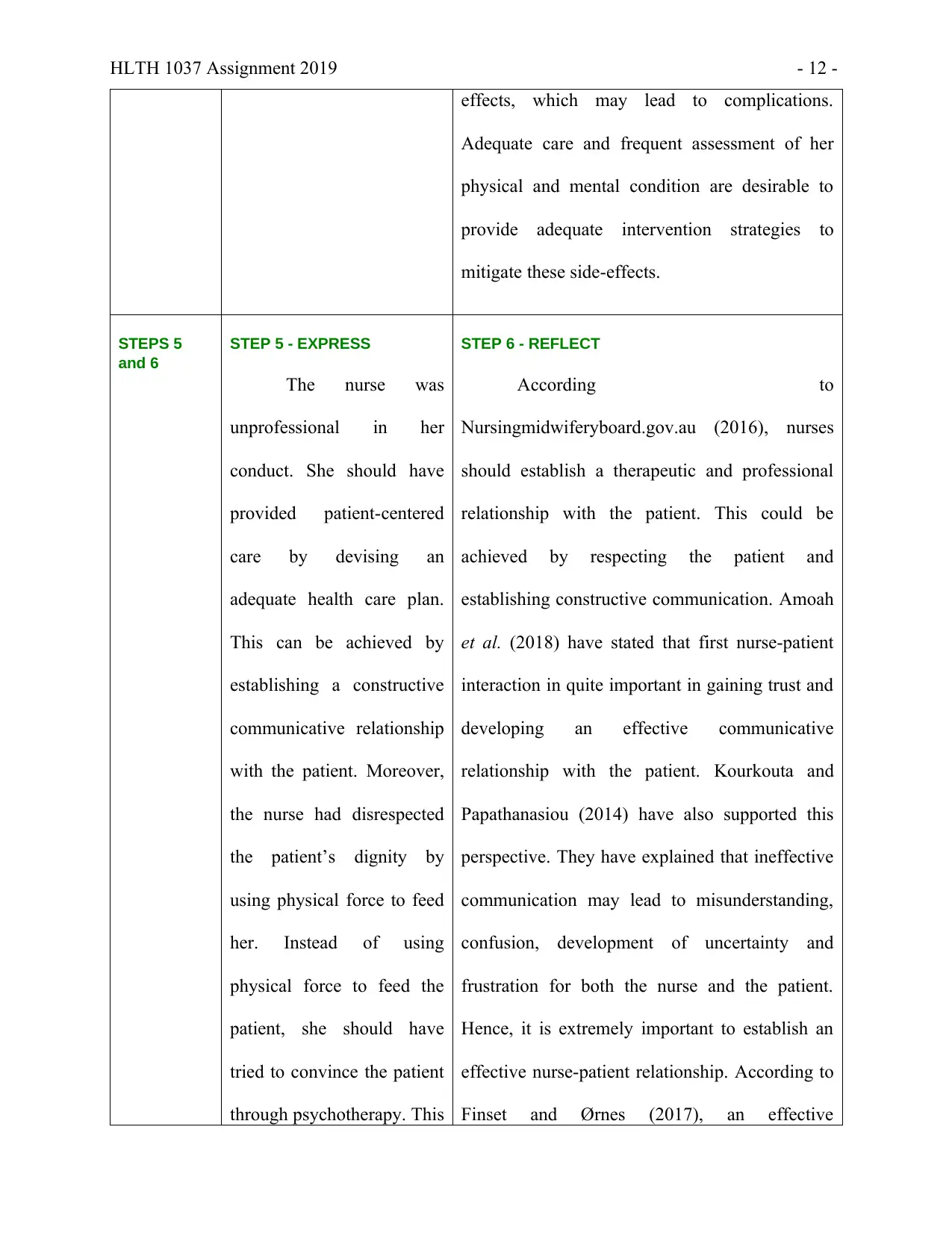
HLTH 1037 Assignment 2019 - 12 -
effects, which may lead to complications.
Adequate care and frequent assessment of her
physical and mental condition are desirable to
provide adequate intervention strategies to
mitigate these side-effects.
STEPS 5
and 6
STEP 5 - EXPRESS
The nurse was
unprofessional in her
conduct. She should have
provided patient-centered
care by devising an
adequate health care plan.
This can be achieved by
establishing a constructive
communicative relationship
with the patient. Moreover,
the nurse had disrespected
the patient’s dignity by
using physical force to feed
her. Instead of using
physical force to feed the
patient, she should have
tried to convince the patient
through psychotherapy. This
STEP 6 - REFLECT
According to
Nursingmidwiferyboard.gov.au (2016), nurses
should establish a therapeutic and professional
relationship with the patient. This could be
achieved by respecting the patient and
establishing constructive communication. Amoah
et al. (2018) have stated that first nurse-patient
interaction in quite important in gaining trust and
developing an effective communicative
relationship with the patient. Kourkouta and
Papathanasiou (2014) have also supported this
perspective. They have explained that ineffective
communication may lead to misunderstanding,
confusion, development of uncertainty and
frustration for both the nurse and the patient.
Hence, it is extremely important to establish an
effective nurse-patient relationship. According to
Finset and Ørnes (2017), an effective
effects, which may lead to complications.
Adequate care and frequent assessment of her
physical and mental condition are desirable to
provide adequate intervention strategies to
mitigate these side-effects.
STEPS 5
and 6
STEP 5 - EXPRESS
The nurse was
unprofessional in her
conduct. She should have
provided patient-centered
care by devising an
adequate health care plan.
This can be achieved by
establishing a constructive
communicative relationship
with the patient. Moreover,
the nurse had disrespected
the patient’s dignity by
using physical force to feed
her. Instead of using
physical force to feed the
patient, she should have
tried to convince the patient
through psychotherapy. This
STEP 6 - REFLECT
According to
Nursingmidwiferyboard.gov.au (2016), nurses
should establish a therapeutic and professional
relationship with the patient. This could be
achieved by respecting the patient and
establishing constructive communication. Amoah
et al. (2018) have stated that first nurse-patient
interaction in quite important in gaining trust and
developing an effective communicative
relationship with the patient. Kourkouta and
Papathanasiou (2014) have also supported this
perspective. They have explained that ineffective
communication may lead to misunderstanding,
confusion, development of uncertainty and
frustration for both the nurse and the patient.
Hence, it is extremely important to establish an
effective nurse-patient relationship. According to
Finset and Ørnes (2017), an effective
⊘ This is a preview!⊘
Do you want full access?
Subscribe today to unlock all pages.

Trusted by 1+ million students worldwide
1 out of 16
Related Documents
Your All-in-One AI-Powered Toolkit for Academic Success.
+13062052269
info@desklib.com
Available 24*7 on WhatsApp / Email
![[object Object]](/_next/static/media/star-bottom.7253800d.svg)
Unlock your academic potential
Copyright © 2020–2025 A2Z Services. All Rights Reserved. Developed and managed by ZUCOL.





